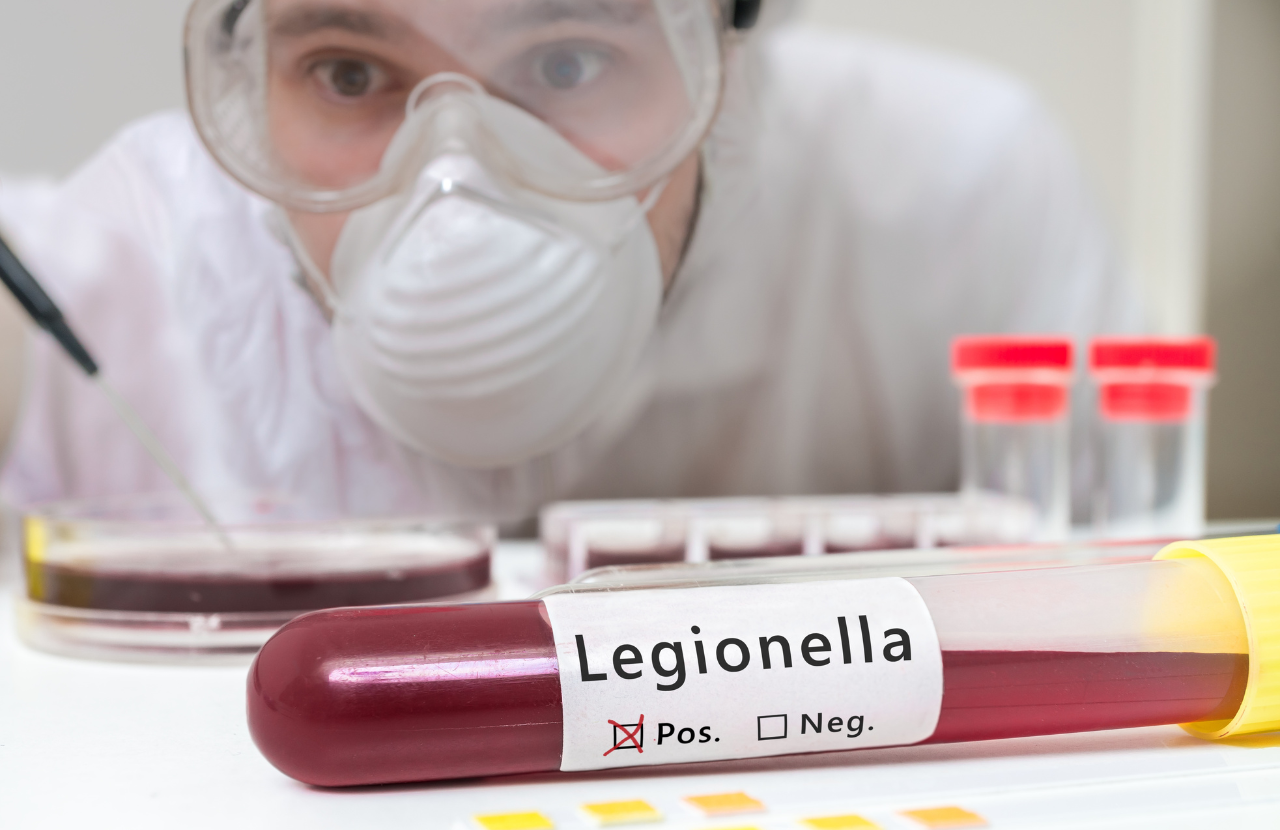
Legionella testing is important for managing water safety risk in buildings, providing confidence that control measures are working to prevent harmful exposure. Legionnaires’ disease, caused by legionella, is a serious form of pneumonia that can be fatal, so preventing microbial growth in water systems is critical.
In this article we explain what conditions cause legionella bacterial growth, how to test for legionella in water, when testing is required, and how different testing methods are used in practice to support decision-making and help maintain legal compliance.
Who is responsible for legionella testing?
The duty holder (the organisation or person in control of premises or water systems in a workplace) is responsible for legionella testing. This may include employers, building owners, landlords, facilities managers, or others with management or maintenance responsibility.
Under the Health and Safety at Work etc. Act 1974, duty holders must protect employees and others from risks to their health. Legionella is one of the foreseeable risks that must be assessed and controlled.
The duty holder will usually appoint a ‘Responsible Person’ to manage legionella controls on their behalf. The Responsible Person may be a ‘competent’ employee or external specialist, but the legal duty for ensuring risks are controlled still rests with the duty holder.
Under Regulation 7 of the Management of Health and Safety at Work Regulations 1999, ‘competent’ means having the appropriate combination of skills, knowledge, experience and training to carry out a task safely and effectively.
How long does legionella take to develop in water?
Legionella bacteria can multiply quickly when conditions are favourable. Early bacterial growth can begin within days, and levels can become significant within a few weeks.
Growth becomes more likely where:
- Water temperature is held in the ‘growth zone’ for long periods. Legionella water temperature (the range in which legionella grows best) is between around 20°C and 45°C. Water systems that drift into this range (for example, systems with poorly controlled calorifiers or long pipe runs where water cools before use) can rapidly become high risk.
- Water sits stagnant in pipework or tanks. Stagnation strips out chlorine residuals, allows biofilm to develop on internal pipe surfaces, and stabilises water in ideal legionella temperature bands. Even a few days of low movement can create a more favourable environment.
- There is nutrient build-up or organic material present. Sediment, scale, rust and biofilm provide the nutrients and surfaces that bacteria need. Systems with older pipework, hard water scale or poorly maintained storage tanks support faster bacterial amplification.
- Disinfection regimes are not maintained. If temperature control, flushing regimes, chemical control or microbiological monitoring lapse, growth can accelerate quickly with little early visual indication.
As a result of these factors, stagnant or intermittently used systems are consistently higher risk. These include:
- Holiday lets between bookings
- Empty or mothballed properties
- Offices with low occupancy
- Healthcare buildings with unused wings or outlets
- Any building with oversized storage capacity where turnover of water is slow.
In all these scenarios, controlling temperature, keeping water moving, keeping systems clean and monitoring regularly are key measures to prevent legionella from establishing a foothold.
How to test for legionella in water
There is no single approach to legionella testing. The method selected depends on factors such as system complexity, the vulnerability of building users, previous sampling results, and the level of assurance the duty holder needs.
For example, healthcare, industrial or high-risk environments often require more robust and frequent testing, while simpler low-risk systems may follow a more proportionate monitoring schedule.
In practice, many organisations use a combination of legionella water testing methods as part of a planned control scheme. They may use laboratory culture tests for definitive compliance evidence, supported by faster or more frequent screening tools to spot early indicators of change before problems escalate.
The most common types of legionella test are:
Laboratory culture tests (most accurate)
Conducted in a specialist laboratory, this method uses selective culture media to grow, detect and quantify live legionella bacteria. This is considered the ‘gold standard’ method in the UK and is used to confirm compliance and identify species and serogroups.
Results can take up to 10–14 days, but they provide formal evidence of whether legionella is present and at what concentration.
These tests are used for in higher risk environments such as healthcare, large industrial systems, or where a control failure or incident is suspected.
PCR testing (faster turnaround)
Polymerase Chain Reaction (PCR) testing detects legionella genetic material in water samples and can provide results within hours or a couple of days.
This test is highly sensitive and useful when rapid insight is needed. However, it cannot always distinguish between live and dead bacteria, so interpretation in the context of risk and other monitoring data is important.
PCR is often used when urgent verification is needed after maintenance, disinfection, or an unexpected temperature or biocide control failure, allowing faster decisions while awaiting the results of laboratory culture tests.
Dip slides or rapid tests (screening tools)
Dip slides or rapid tests are used on-site to provide a quick indication of whether microbial activity in the water system is increasing. They do not directly identify legionella, but they show general bacterial growth levels (total viable count).
These tests are useful as a warning measure between formal laboratory tests and can help indicate when a system may be deteriorating or requires intervention sooner. They are commonly used in lower risk premises, or as an additional routine check in higher risk sites to support decision-making between scheduled laboratory tests.
Legionella testing requirements UK
There are no specific legionella regulations, but legionella testing requirements in the UK are set out through Health and Safety Executive (HSE) guidance. The two core documents that duty holders must understand are the Approved Code of Practice L8 (ACoP L8) and HSG274.
Approved Code of Practice L8 (ACoP L8)
ACoP L8 sets out the legal duties for controlling legionella bacteria in water systems and explains what duty holders must do to comply with the Health and Safety at Work etc. Act 1974, the Control of Substances Hazardous to Health Regulations 2002 (COSHH), and the Management of Health and Safety at Work Regulations 1999.
These health and safety laws do not name legionella specifically, but they apply because legionella is classified as a biological agent that can harm health. Under these laws employers must assess the risk and put in place suitable control measures, in the same way they would for any other workplace hazard that could cause illness or disease.
ACoP L8 requires duty holders to:
Carry out a suitable and sufficient legionella risk assessment
Duty holders must first understand where legionella risk exists within their water systems. A risk assessment identifies the sources of risk, who may be harmed, and what needs to be done to prevent or manage exposure. The findings will also determine whether routine or periodic legionella sampling is required as part of the overall control strategy.
For more information, please read our article, What is a legionella risk assessment?
Establish and implement a written scheme of control
A written scheme of control sets out the specific controls an organisation uses to manage legionella risk. It should identify roles, responsibilities, and detailed actions required to maintain safe conditions (for example temperature control parameters, flushing regimes, biocide dosing, inspection schedules, cleaning and disinfection frequency, and any sampling requirements).
The written scheme is not a single document that gets filed away: it must be actively followed, maintained, reviewed, and kept up to date whenever systems or risks change.
Monitor the effectiveness of control measures
Duty holders must verify that legionella controls are working in practice. Monitoring can include temperature checks, inspections, condition surveys, and where required, legionella sampling and laboratory testing to confirm that risk remains under control. The need for sampling will be determined by the risk assessment and the written scheme of control.
Records of monitoring must be kept, and any deviations or failures must trigger corrective action. Monitoring confirms that the control measures described in the written scheme are keeping the system safe over time.
HSG274 technical guidance (parts 1–3)
HSG274 provides technical guidance on how to comply with ACoP L8 in different types of water system. It explains how to apply monitoring, maintenance and testing in practice, based on the type of system in use and the level of risk identified.
HSG274 is split into three parts:
Part 1 – evaporative cooling systems
Part 1 covers cooling towers, evaporative condensers and cooling systems associated with industrial or process equipment.
These systems generate aerosols – tiny droplets of water that become airborne and can be breathed in. As legionella infection occurs through inhalation of contaminated water droplets, systems that produce aerosols present a higher risk of spreading legionella bacteria if not properly controlled.
Part 1 provides detailed guidance on inspection, cleaning, water treatment, biocides, drift control, testing regimes and monitoring requirements.
Part 2 – hot and cold water systems
Part 2 is most relevant for workplaces such as offices, schools, retail units, blocks of flats and leisure facilities. It sets out what duty holders must do to manage legionella in standard hot and cold water systems, including flushing routines, temperature control, storage tank inspection, and when sampling should be undertaken.
Part 2 also covers special considerations such as dead legs (sections of pipework with little or no flow), TMVs (thermostatic mixing valves used to control outlet temperatures), and infrequently used outlets (taps or showers that are not regularly operated and can allow water to stagnate).
Part 3 – other risk systems
Part 3 covers all other engineered water systems that could create and disseminate aerosols, such as spa pools, vehicle wash systems, humidifiers, indoor fountains, or misting systems. It provides technical control measures specific to each system type, alongside monitoring and testing guidance where higher or variable risks may exist.
HSG274 also explains when sampling may be required and gives practical guidance on recommended methods and frequency, depending on the system type and risk level.
Although not every system requires routine sampling, many organisations still choose to carry out periodic sampling as part of ongoing monitoring, because it provides reassurance and evidence that their controls remain effective.
Legionella Responsible Person Training
Legionella Responsible Person Training provides the knowledge and practical understanding needed to manage legionella risks effectively, including when and how legionella testing should be part of ongoing monitoring and compliance.
The course explains the legal framework, the duties and expectations placed on the Responsible Person, and how to oversee and review risk assessments. It also covers water system design, common control measures, record keeping, monitoring and inspection, and how to respond to incidents or suspected outbreaks.
Legionella Responsible Person Training can be tailored to your organisation, and it is available via eLearning, through a virtual classroom, or face-to-face at a venue of your choice. Find out more on our website, or contact our friendly team today on 0203 011 4242 / info@praxis42.com

Adam Clarke
Managing Director (Consulting)
